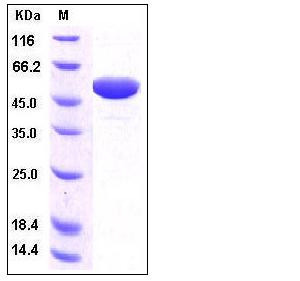Human ApoAI Protein (Fc Tag)
Apolipoprotein A-I
- 100ug (NPP1904) Please inquiry
| Catalog Number | P10686-H02H |
|---|---|
| Organism Species | Human |
| Host | Human Cells |
| Synonyms | Apolipoprotein A-I |
| Molecular Weight | The recombinant human APOA1/Fc is a disulfide-linked homodimeric protein.The reduced monomer consists of 481 amino acids migrates as approximately 55 kDa band in SDS-PAGE under reducing conditions as predicted. |
| predicted N | Asp 25 |
| SDS-PAGE |  |
| Purity | > 95 % as determined by SDS-PAGE |
| Protein Construction | A DNA sequence encoding the pro-form of human APOA1 (CAA26097.1) (Met 1-Gln 267) was fused with Fc region of human IgG1 at the C-terminus. |
| Bio-activity | 1. Measured by its binding ability in a functional ELISA. 2. Immobilized Human ApoAI at 10 μg/mL (100 μl/well) can bind biotinylated human SCARB1, The EC50 of biotinylated human SCARB1 is 0.37 μg/mL. |
| Research Area | Cardiovascular |Atherosclerosis |Lipoprotein metabolism |
| Formulation | Lyophilized from sterile 100mM Glycine, 10mM NaCl, 50mM Tris, pH 7.5 1. Normally 5 % - 8 % trehalose and mannitol are added as protectants before lyophilization. Specific concentrations are included in the hardcopy of COA. |
| Background | Apolipoprotein A1 (APOA1) is a member of the apolipoprotein family whose members are proteins bind with lipids and form lipoproteins to translate these oil-soluble lipids such as fat and cholesterol through lymphatic and circulatory system. APOA1 is the main component of high density lipoprotein (HDL) in plasma and is involved in the esterification of cholesterol as a cofactor of lecithin-cholesterol acyltransferase (LCAT) which is responsible for the formation of most plasma cholesteryl esters, and thus play a major role in cholesterol efflux from peripheral cells. As a major component of the HDL complex, APOA1 helps to clear cholesterol from arteries. APOA1 is also characterized as a prostacyclin stabilizing factor, and thus may have an anticlotting effect. Defects in encoding gene may result in HDL deficiencies, including Tangier disease, and with systemic non-neuropathic amyloidosis. Men carrying a mutation may develop premature coronary artery disease. |
| Reference |
